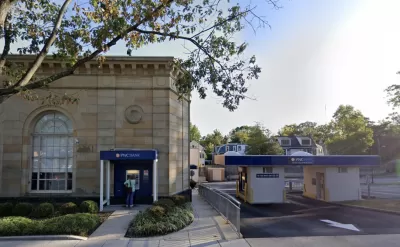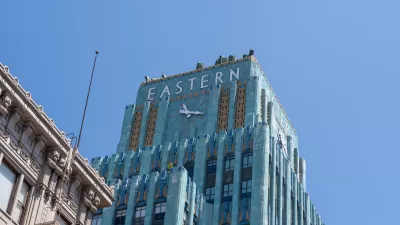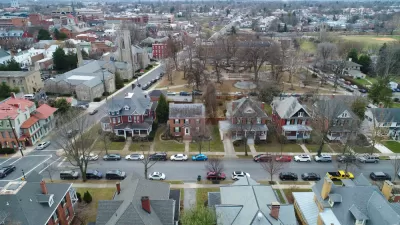The decision to protect a non-historic parking lot as part of designating an adjacent historic bank building is being derided by critics as another form of exclusionary zoning.

The inclusion of a parking lot in a historic landmark designation by the District of Columbia’s Historic Preservation Review Board (HPRB) is raising eyebrows, writes Nick Sementelli in Greater Greater Washington, causing concern among housing advocates who say the decision will limit any future development on the lot.
The historic building at the heart of the matter is the Chevy Chase Savings Bank on Connecticut Avenue. “The landmarking of the building follows HPRB’s established norms, but the inclusion of a parking lot adjacent to the site seems to violate the board’s own precedent and national historic guidance.”
Although “Using the historic nomination process like this to control future land use is supposed to be impermissible,” the HPRB acted on the claim from Historic Chevy Chase and the DC Preservation League (DCPL) that preserving the lot is important “to prevent too tall a building from being built on the lot in the future” and “ruin” the bank building’s ambiance.
According to DCPL Executive Director Rebecca Miller, “the bank and the parking lot share a single tax lot, and that DCPL uses tax-lot boundaries when drafting nominations.” The preservation groups say they are “not trying to prevent all development on the parking lot,” but having to go through historic design review in the future will likely ensure that any future building will be limited in size.
For Sementelli, “Preemptively limiting the scale of infill development on a parking lot by surreptitiously sliding it into a landmark application for a specific building” looks suspiciously like exclusionary zoning that “is supposed to be legally out of bounds.”
FULL STORY: DC’s historic board voted to protect a non-historic parking lot. Why?

Alabama: Trump Terminates Settlements for Black Communities Harmed By Raw Sewage
Trump deemed the landmark civil rights agreement “illegal DEI and environmental justice policy.”

Planetizen Federal Action Tracker
A weekly monitor of how Trump’s orders and actions are impacting planners and planning in America.

Why Should We Subsidize Public Transportation?
Many public transit agencies face financial stress due to rising costs, declining fare revenue, and declining subsidies. Transit advocates must provide a strong business case for increasing public transit funding.

Understanding Road Diets
An explainer from Momentum highlights the advantages of reducing vehicle lanes in favor of more bike, transit, and pedestrian infrastructure.

New California Law Regulates Warehouse Pollution
A new law tightens building and emissions regulations for large distribution warehouses to mitigate air pollution and traffic in surrounding communities.

Phoenix Announces Opening Date for Light Rail Extension
The South Central extension will connect South Phoenix to downtown and other major hubs starting on June 7.
Urban Design for Planners 1: Software Tools
This six-course series explores essential urban design concepts using open source software and equips planners with the tools they need to participate fully in the urban design process.
Planning for Universal Design
Learn the tools for implementing Universal Design in planning regulations.
Caltrans
Smith Gee Studio
Institute for Housing and Urban Development Studies (IHS)
City of Grandview
Harvard GSD Executive Education
Toledo-Lucas County Plan Commissions
Salt Lake City
NYU Wagner Graduate School of Public Service





























